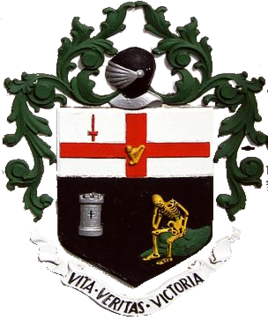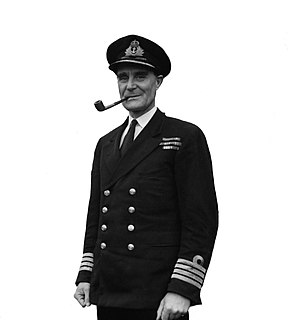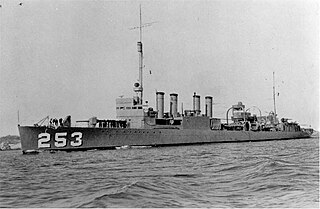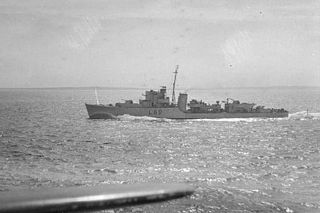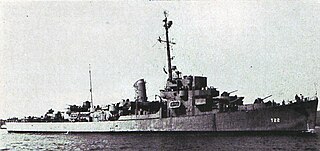 HMS Blankney in 1943 | |
| History | |
|---|---|
| Name: | HMS Blankney |
| Ordered: | 4 September 1939 |
| Builder: | John Brown & Company |
| Yard number: | 569 |
| Laid down: | 17 May 1940 |
| Launched: | 19 December 1940 |
| Commissioned: | 11 April 1941 |
| Honours and awards: | Atlantic 1941–43, Malta Convoys 1942, Arctic 1942–43, Sicily 1943, Salerno 1943, Normandy 1944, Mediterranean 1944. |
| Fate: | Scrapped in 1958 |
| Badge: | On a Field Red, a griffin's head erased Gold in front of two hunting horns in saltire White. |
| General characteristics Type II | |
|---|---|
| Class and type: | Hunt-class destroyer |
| Displacement: |
|
| Length: | 85.3 m (279 ft 10 in) o/a |
| Beam: | 9.6 m (31 ft 6 in) |
| Draught: | 2.51 m (8 ft 3 in) |
| Propulsion: |
|
| Speed: |
|
| Range: | 3,600 nmi (6,700 km) at 14 kn (26 km/h) |
| Complement: | 164 |
| Armament: |
|
HMS Blankney was a Hunt-class destroyer of the Royal Navy and was the first and so far only warship to bear the Name. [1] She was laid down on 17 May 1940 at John Brown & Company, Clydebank, Scotland, launched on 19 December 1940 and commissioned on 11 April 1941.

The Hunt class was a class of escort destroyer of the Royal Navy. The first vessels were ordered early in 1939, and the class saw extensive service in the Second World War, particularly on the British east coast and Mediterranean convoys. They were named after British fox hunts. The modern Hunt class GRP hulled mine countermeasure vessels maintain the Hunt names lineage in the Royal Navy.

In naval terminology, a destroyer is a fast, maneuverable long-endurance warship intended to escort larger vessels in a fleet, convoy or battle group and defend them against smaller powerful short-range attackers. They were originally developed in the late 19th century by Fernando Villaamil for the Spanish Navy as a defense against torpedo boats, and by the time of the Russo-Japanese War in 1904, these "torpedo boat destroyers" (TBDs) were "large, swift, and powerfully armed torpedo boats designed to destroy other torpedo boats". Although the term "destroyer" had been used interchangeably with "TBD" and "torpedo boat destroyer" by navies since 1892, the term "torpedo boat destroyer" had been generally shortened to simply "destroyer" by nearly all navies by the First World War.

The Royal Navy (RN) is the United Kingdom's naval warfare force. Although warships were used by the English kings from the early medieval period, the first major maritime engagements were fought in the Hundred Years War against the Kingdom of France. The modern Royal Navy traces its origins to the early 16th century; the oldest of the UK's armed services, it is known as the Senior Service.
Contents
- Service history
- 12th escort group
- Arctic convoys
- Operations in the Mediterranean
- D-Day, 6 June 1944
- End of the War
- Fate
- Commanders
- Notes
- References
- External links
Blankney was one of 33, Type II Hunt Escort Destroyers. The hulls of this second batch had an extra section which with the increased beam, gave stability for a third twin 4" AA gun to be mounted as originally designed and to give additional storage for depth charges (increased from 40 to 110). The class were named after fox hunts located in different parts of Britain and in Blankney's case, this was the Blankney Hunt, a fox-hunting pack based in the North Kesteven district of Lincolnshire. [2]

An escort destroyer with United States Navy hull classification symbol DDE was a destroyer (DD) modified for and assigned to a fleet escort role after World War II. These destroyers retained their original hull numbers. Later, in March 1950, the post World War II ASW destroyer (DDK) classification was merged with the DDE classification, resulting in all DDK ships being reclassified as DDE, but again retaining their original hull numbers. On 30 June 1962, the DDE classification was retired, and all DDEs were reclassified as destroyers (DD). Escort destroyers should not be confused with the cheaper, slower, less capable, and more lightly armed World War II destroyer escorts.
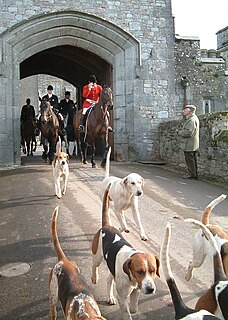
Fox hunting is an activity involving the tracking, chase and, if caught, the killing of a fox, traditionally a red fox, by trained foxhounds or other scent hounds, and a group of unarmed followers led by a "master of foxhounds", who follow the hounds on foot or on horseback.
In 1942 the British Wartime Government introduced a National Savings campaign named "Warship Week" where towns could "adopt" a Royal Navy ship. Blankney was adopted by Nantwich in Cheshire. The town still has two roads named after the destroyer, Blankney Avenue and The Blankney. There is a plaque hanging in Civic Hall, commemorating the towns support for the crew. [3]

The Churchill war ministry was a Conservative-led coalition government in the United Kingdom that lasted for most of the Second World War. It was led by Winston Churchill, who was appointed by King George VI as Prime Minister of the United Kingdom. Formed in 1940 in the aftermath of the Norway Debate and within a year of declaring war on Nazi Germany, it persisted until May 1945, when Churchill resigned and an election was called.
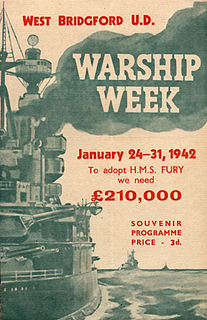
Warship Weeks were British National savings campaigns during the Second World War, with the aim of a Royal Navy warship being adopted by a civil community. During the early parts of the war, the Royal Navy not only had lost many capital ships but was facing increasing pressure to provide escorts for convoys in the Atlantic. While there was not a shortage of sailors, ships sunk by enemy action had to be replaced.
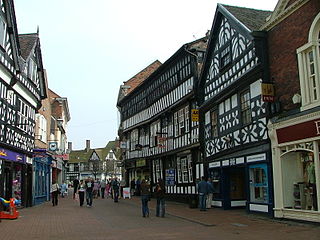
Nantwich is a market town and civil parish in Cheshire, England. It is known for having amongst the highest concentrations of listed buildings in England, with particularly good examples of Tudor and Georgian architecture. In 2011, it had a population of 17,424.
